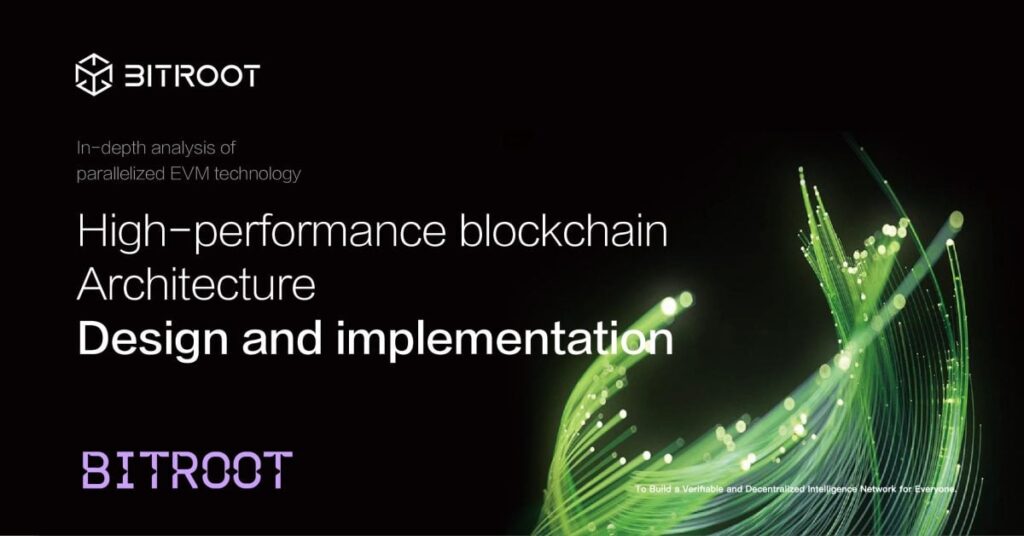Over the past decade, blockchain scalability has remained the primary barrier to mass adoption. Ethereum, processing around 15 transactions per second (TPS), has long exposed the limitations of serial execution models. Bitroot emerges as a next-generation Layer 1 blockchain that breaks these constraints – achieving 100,000 TPS and 300 ms finality through a combination of Pipeline BFT consensus, optimistic parallelized EVM, state sharding and BLS signature aggregation.
A layered architecture designed for performance
Bitroot’s five-layer modular design (storage, network, consensus, protocol and application) ensures both scalability and maintainability.
The storage layer incorporates distributed partitioning to reduce state overhead and enable validation on ordinary hardware.
The network layer uses Kademlia DHT and GossipSub, optimized for large-scale data transfer.
The consensus layer, powered by Pipeline BFT, decouples consensus from execution, allowing new blocks to progress even before previous blocks are finalized.
The protocol layer introduces a parallel execution engine that remains fully EVM compatible, supporting seamless migration for Ethereum-based applications.
The application layer provides standardized SDKs and interfaces for rapid DApp development.
This modularity allows Bitroot to scale quickly without disrupting existing infrastructure – a key differentiator from monolithic blockchain designs.
BFT pipeline: consensus at assembly line speed
Traditional BFT systems, such as Tendermint, are limited by serialized block confirmation and high communication complexity (O(n²)). Bitroot’s BFT Pipeline reimagines consensus as a four-step assembly line: Propose, Pre-Vote, Pre-Commit, and Commit – allowing multiple blocks to be processed simultaneously.
This pipelined mechanism, combined with BLS signature aggregation, reduces confirmation latency to 300 milliseconds and compresses signature verification from O(n) to O(1). By decoupling consensus from execution and enabling batch processing, Bitroot achieves industry-leading scalability without sacrificing decentralization.
Optimistic Parallelized EVM: Unlocking Multi-Core Potential
Bitroot’s Optimistic Parallelized EVM (OPEVM) eliminates the single-threaded limitations of traditional EVMs.
It introduces a three-step conflict detection system: static analysis before execution, dynamic monitoring during execution, and global verification after execution, ensuring both security and efficiency under high concurrency conditions.
With intelligent transaction pooling, fine-grained read/write locks, and NUMA-aware scheduling, Bitroot maintains optimal CPU utilization (90%) and achieves up to 7-12x higher throughput than Ethereum’s serial EVM.
The result: deterministic parallelism without compromising correctness – a critical step toward AI-enabled blockchain computing.
State Sharing: True Horizontal Scalability
To support exponential growth, Bitroot implements state sharing by distributing account states across multiple shards. Each shard maintains an independent state tree, while a shard coordinator ensures atomicity and consistency via a two-phase commit protocol.
This design allows for linear scalability — as the number of shards increases, throughput scales proportionally — providing a sustainable path for long-term growth.
Performance validation and ecosystem integration
Benchmark tests on AWS infrastructure demonstrated 25,600 TPS, 1.2 seconds total latency, and 85% resource utilization, outperforming comparable Layer 1 networks by more than 50x. Gas fees are reduced by up to 90%, positioning Bitroot as a practical alternative to Layer 2 solutions while maintaining complete decentralization.
Bitroot’s EVM compatibility allows developers to migrate Ethereum applications seamlessly, accelerating the adoption of DeFi, NFT, gaming, and enterprise applications. Its upcoming AI integration framework further expands the possibilities, enabling decentralized AI agents and on-chain machine learning models.
Conclusion: Infrastructure for the Intelligent Web3 Era
Bitroot represents a major step forward in blockchain engineering, transforming academic research into real-world performance.
By combining Pipeline BFT, Optimistic Parallelized EVM and State Sharding, Bitroot provides a comprehensive model for high-performance blockchain systems.
It not only bridges the gap between performance and decentralization, but also lays the technical foundation for the convergence of AI and Web3.
As demand for intelligent, scalable and interoperable infrastructure increases, Bitroot is ready to power the next generation of decentralized applications – from real-time finance to AI-driven ecosystems.
Bitroot invites Web3 users around the world to join us and look forward to building together! Web: bitroot.co
Disclaimer: The Block is an independent media outlet providing news, research and data. Since November 2023, Foresight Ventures has been a majority investor in The Block. Foresight Ventures invests in other companies in the crypto sector. Crypto exchange Bitget is an anchor LP for Foresight Ventures. The Block continues to operate independently to provide objective, impactful and current information about the crypto industry. Here is our current financial information.
© 2025 The Block. All rights reserved. This article is provided for informational purposes only. It is not offered or intended to be used as legal, tax, investment, financial, or other advice.




